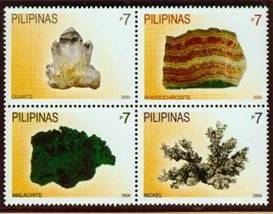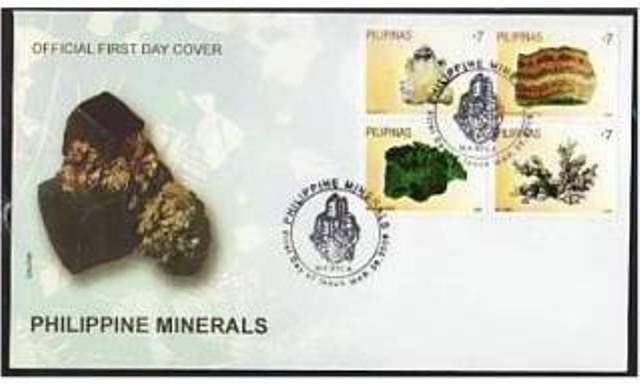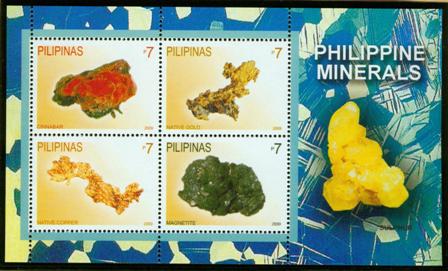2009, March 25. Philippine Minerals
Litho Offset. Amstar Company, Inc. Perf. 14.
Se-tenant Blocks of 4 (10 Blocks per sheet) , Sheets of 40 (4 x 10); Souvenir Sheets of 4

Se-tenant Blocks of Four (25,000)
7p Quartz
7p Rhodochrosite
7p Malachite
7p Nickel
Souvenir Sheets of Four (5,000)
7p Cinnabar
7p Native Gold
7p Native Copper
7p Magnetite
First Day Covers: Manila

Official FDCs: 2 different designs; 400 each issued at P72 a pair
PHILIPPINE MINERALS
7p Quartz - Quartz belongs to the rhombohedral crystal system. The ideal crystal shape is a six-sided prism terminating with six-sided pyramids at each end. In nature quartz crystals are often twinned, distorted, or so inter-grown with adjacent crystals of quartz or other minerals as to only show part of this shape, or to lack obvious crystal faces altogether and appear massive. Well-formed crystals typically form in a 'bed' that has unconstrained growth into a void, but because the crystals must be attached at the other end to a matrix, only one termination pyramid is present. A quartz geode is such a situation where the void is approximately spherical in shape, lined with a bed of crystals pointing inward. (http://en.wikipedia.org/wiki/Quartz)
7p Rhodochrosite - Rhodochrosite (whose name means rose-colored) is a very attractive mineral with an absolutely one-of-a-kind, beautiful color. Although it can be an ore of manganese, it is its ornamental and display specimen qualities that make it a very popular mineral. The color of a single crystal can just astound the observer with its vivid pink-rose color that seems to be transmitted out of the crystal as if lit from within. (http://www.galleries.com/minerals/CARBONAT/RHODOCHR/rhodochr.htm)
7p Malachite - Malachite is a green mineral with a widely variable habit. Typically it is found as crystalline aggregates or crusts, often banded in appearance, like agates. It is also often found as botryoidal clusters of radiating crystals, and as mammillary aggregates as well. Single crystals and clusters of distinguishable crystals are uncommon, but when found they are typically acicular to prismatic. It is also frequently found as a pseudo morph after Azurite crystals, which are generally more tabular in shape. (http://www.mindat.org/min-2550.htm)
7p Nickel - The vast nickel laterites of Surigao in northeastern Mindanao were first reported in 1912, although these were not exploited until 1975. The first production of nickel in the Philippines was from nickel sulphide, which was found during the course of chromite mining at Acoje, Zambales. Up to 400 metric tons of beneficiated nickel sulphide were produced from 1970 to 1976. The nickel deposits at Nonoc, Surigao del Norte were mined from 1975 to 1982. The escalating cost of fuel soon posed problems because of the energy intensive recovery process involved. During this period, production of nickel (as metal) ranged from 9,600 to 25,000 metric tons per annum. (http://www.mgb.gov.ph/asomm/min_resources.htm)
7p Cinnabar - Cinnabar is a colorful mineral that adds a unique color to the mineral color palette. Its cinnamon to scarlet red color can be very attractive. Well shaped crystals are uncommon and the twinned crystals are considered classics among collectors. The twinning in cinnabar is distinctive and forms a penetration twin that is ridged with six ridges surrounding the point of a pyramid. It could be thought of as two scalahedral crystals grown together with one crystal going the opposite way of the other crystal. Cinnabar was mined by the Roman Empire for its mercury content and it has been the main ore of mercury throughout the centuries. Some mines used by the Romans are still being mined today. Cinnabar shares the same symmetry class with quartz but the two form different crystal habits. (http://www.galleries.com/MINERALS/sulfides/cinnabar/cinnabar.htm)
7p Native Gold - Lode and placer gold deposits occurring most of the 73 provinces in the Philippines. The principal producing districts are Baguio and Paracale in Luzon; and Masbate, Surigao and Masara in Mindanao. Gold production in 2003 totaled 37,800 kg compared to 35,800 kg in 2002.
7p Native Copper - Mining of copper in the Philippines also has a long history although until the second half of this century it was inferior to gold in value. Crudely-smelted copper was traded with the Chinese in the 14th Century. Late in the Spanish era copper mines were opened at Carawisan (in Panay) in 1842 and at Mankayan (northern Luzon) in 1864. In 1974, there were 18 copper mines in operation, most of them of porphyry-type. Production peaked at 304,500 metric tons of copper in metal in 1980, but declined markedly beginning 1982. For the past several years, annual production has averaged around 200,000 metric tons. Constituting 35% of the country’s mine production by value. As mentioned earlier, gold and silver are important by-product of copper mining. (http://www.mgb.gov.ph/asomm/min_resources.htm)
7p Magnetite - Collected at the water depth of 1989 meters on the Benham Rise of the western Philippine Sea, composed of olive-brown hemi-pelagic calcareous oozes and intercalated with volcanic ash layers in 1-15 cm thickness. Analysis of magnetic mineralogy and granulometry reveals that the main magnetic carrier of sediments is magnetite with grain sizes within the range of pseudo-single domain. (http://www.earth.sinica.edu.tw/papers/HorngCS/JGSC2000_MD972143.pdf)
PHILIPPINE GEOLOGY AND MINERALIZATION: AN OVERVIEW
The Philippines may be viewed as a collage of metamorphic terranes, magma tic arcs, ophiolitic complexes, sedimentary basins and continental block of Eurasian affinity subjected to tectonic processes such as subduction, collision and major strike slip faulting. The subduction zones are represented on the east by the west dipping Philippine Trench traversing the eastern seaboard of the Philippines from Mindanao up to a point in Luzon and the East Luzon Trough. East dipping subduction zones include the Manila Trench, Negros Trench and Cotabato Trench. The southern termination of the Manila Trench is characterized by the transformation of the subduction of the South China Sea Plate into an arc-continent collisional deformation within Mindoro Island.
The continental block is represented by northern Palawan, southern Mindoro, Romblon Island Group and Buruanga Peninsula in Panay Island, known collectively as the North Palawan Block. Rock suites in this block include schists that are characteristically rich in quartz and chart formations that have been dated Late Permian to Jurassic.
The rest of the archipelago is considered as the Philippine Mobile Belt. Approximately co-axial with the mobile belt is the Philippine Fault, a major strike slip fault that apparently developed partially in response to the kinematic forces from the subduction from the east and west of the mobile belt.
Many areas of this mobile belt are underlain by ophiolitic complexes. Usually occurring together with pre-Cenozoic schists and phyllites, the ophiolitic rocks represent basement on which magma tic arcs have developed. The ages of the ophiolitic complexes range from Jurassic to early Paleogene. One of the best studied complete ophiolite sequence is the Zambales Ophiolite where tectonized peridotites progress to layered and isotropic gabbro, sheeted dike complex, pillow basalts and finally pelagic sedimentary rocks. Other ophiolitic complexes include those in Isabela, Polillo Island, eastern Rizal, Camarines Norte, Caramoan Peninsula, Mindoro, southern Palawan, Panay Island, Bohol Island, Leyte Island, Samar Island, Dinagat Island Group, north-central Zamboanga, Mindanao Central Cordillera and Pujada Peninsula. Ultramafic rocks of these ophiolites are hosts to significant deposits of chromite and nickel. Laterites over these rocks also contain economic deposits of secondary nickel minerals. On the other hand, massive sulphide and manganese deposits are associated with the volcanic and sedimentary carapace of the ophiolite.
Ancient magma tic arcs in the mobile belt are characterized by thick volcanic flows intercalated with pyroclastic and sedimentary rocks and intrusions of diorite, quartz diorite and andesitic to dacitic rocks. Some intrusions, however, have a more alkalic character such as the syenites in Isabela and monzonites in Quirino and Nueva Vizcaya. The ages of the diorite intrusions vary, from late Early Cretaceous (Albian) in Cebu to Late Miocene-Pliocene (Black Mountain Quartz Diorite in Baguio District). Younger volcanic rocks, occurring as flows, intrusions and volcanic edifices disposed in linear belts are associated with active subduction processes. These are best exemplified by the Bataan volcanic belt and Bicol volcanic chain.
Sedimentary basins located between arcs include the Ilocos-Central Valley Basin, Cagayan Valley Basin, southeast Luzon Basin, Visayan Sea Basin, Agusan-Davao Basin and Cotabato Basin.
Gold and copper deposits in the Philippines tend to be clustered in certain areas such as Luzon Central Cordillera, Camarines Norte, Surigao and Davao, although large deposits may also be found elsewhere, as in Zambales (Dizon mine), Cebu (Atlas mine) and South Cotabato (Tampakan project). Many copper-gold deposits are associated with intrusions (mostly diorite and quartz diorite, but also monzonites and syenites) as well as Pliocene – Pleistocene volcanism (Lepanto mine at Mankayan, Benguet). Iron deposits are also associated with Neogene intrusions of diorite and quartz diorite.
(http://www.mgb.gov.ph/miningportal/geology/Geology.pdf)
-
Minerals / Stones
